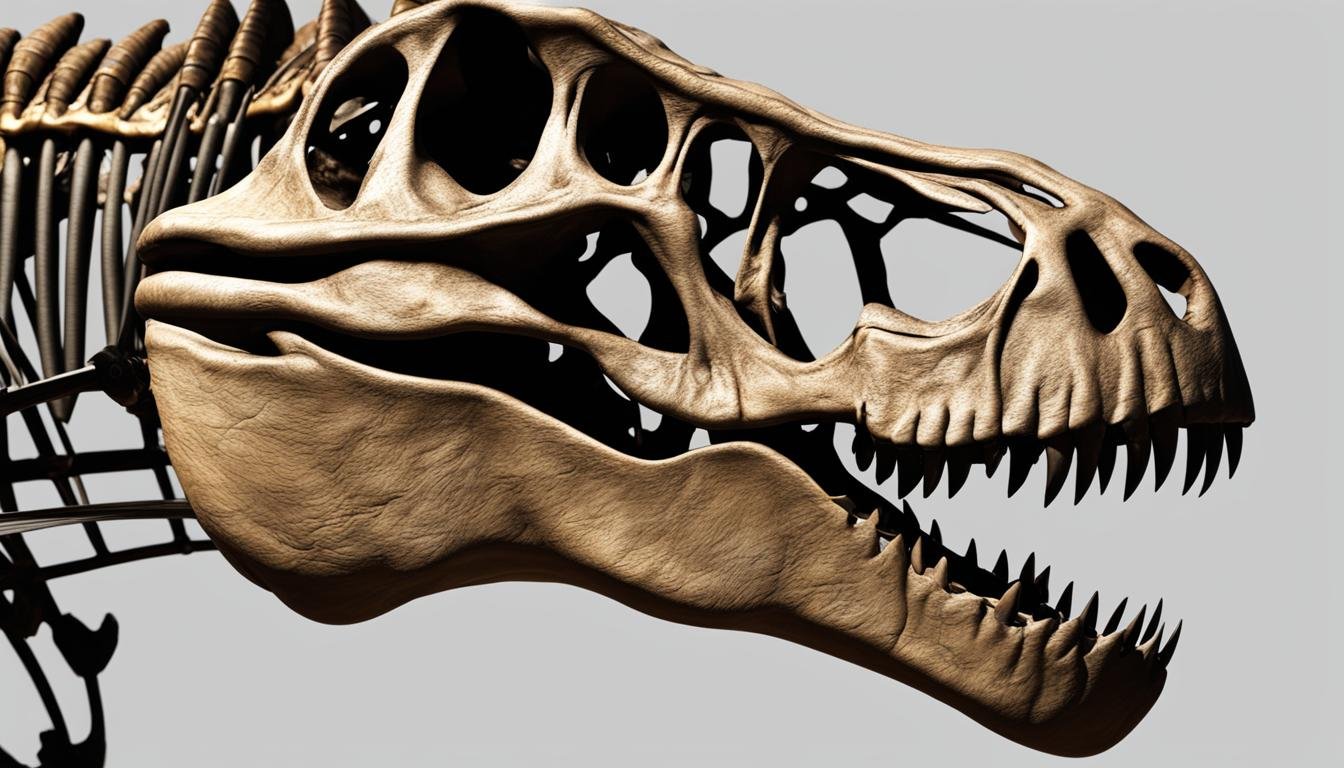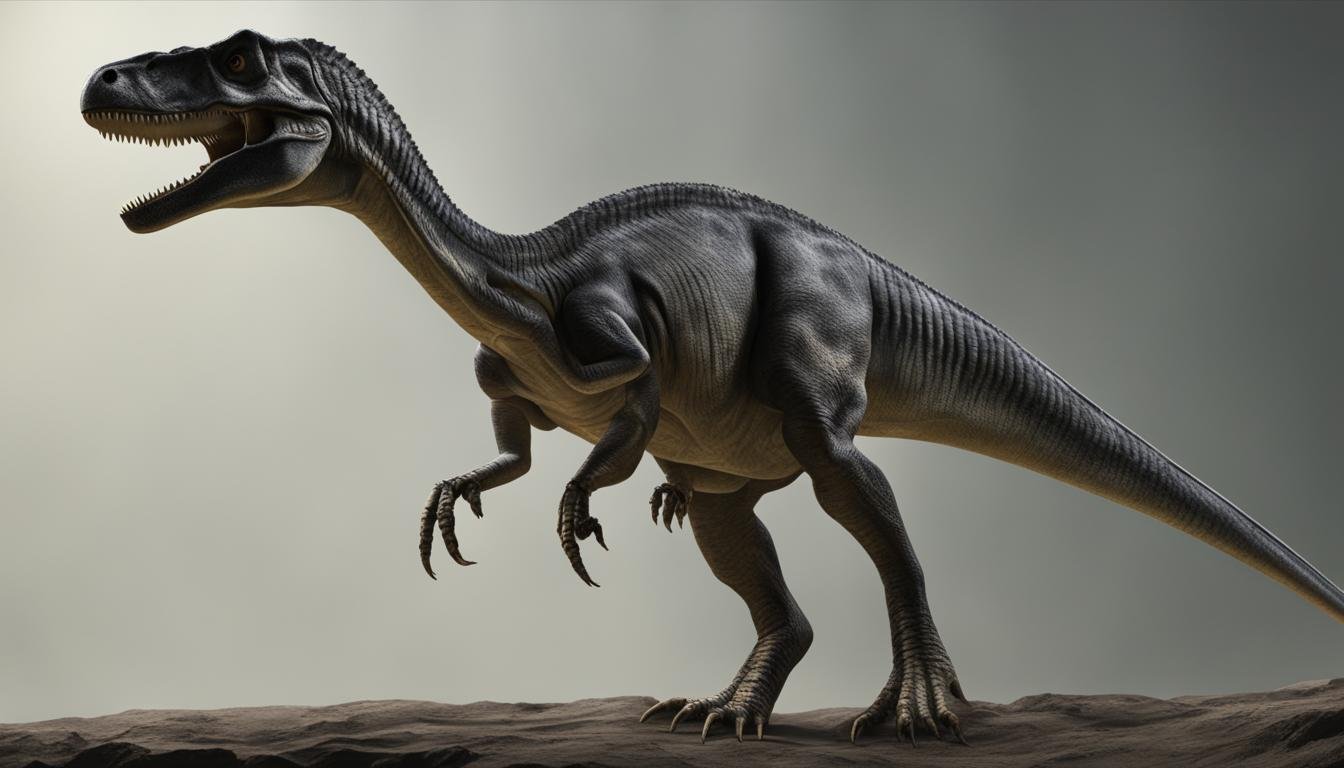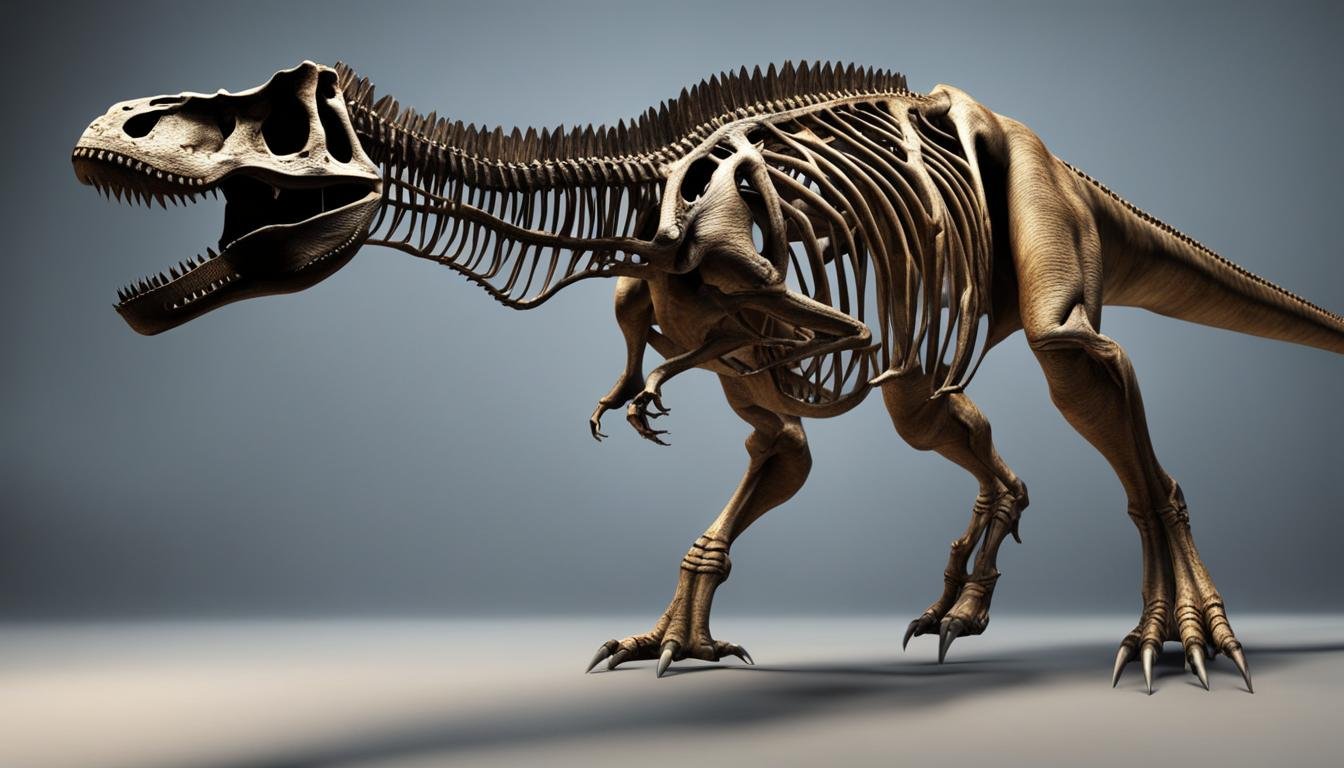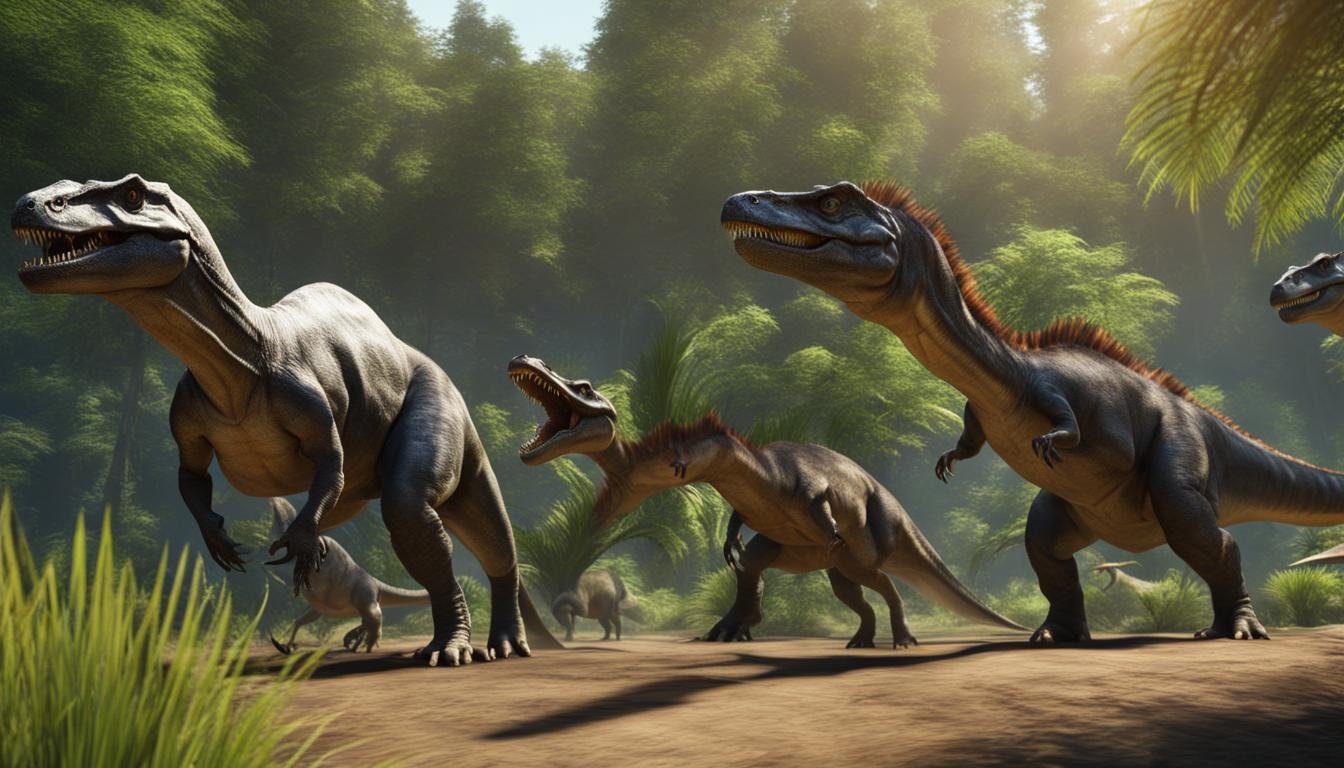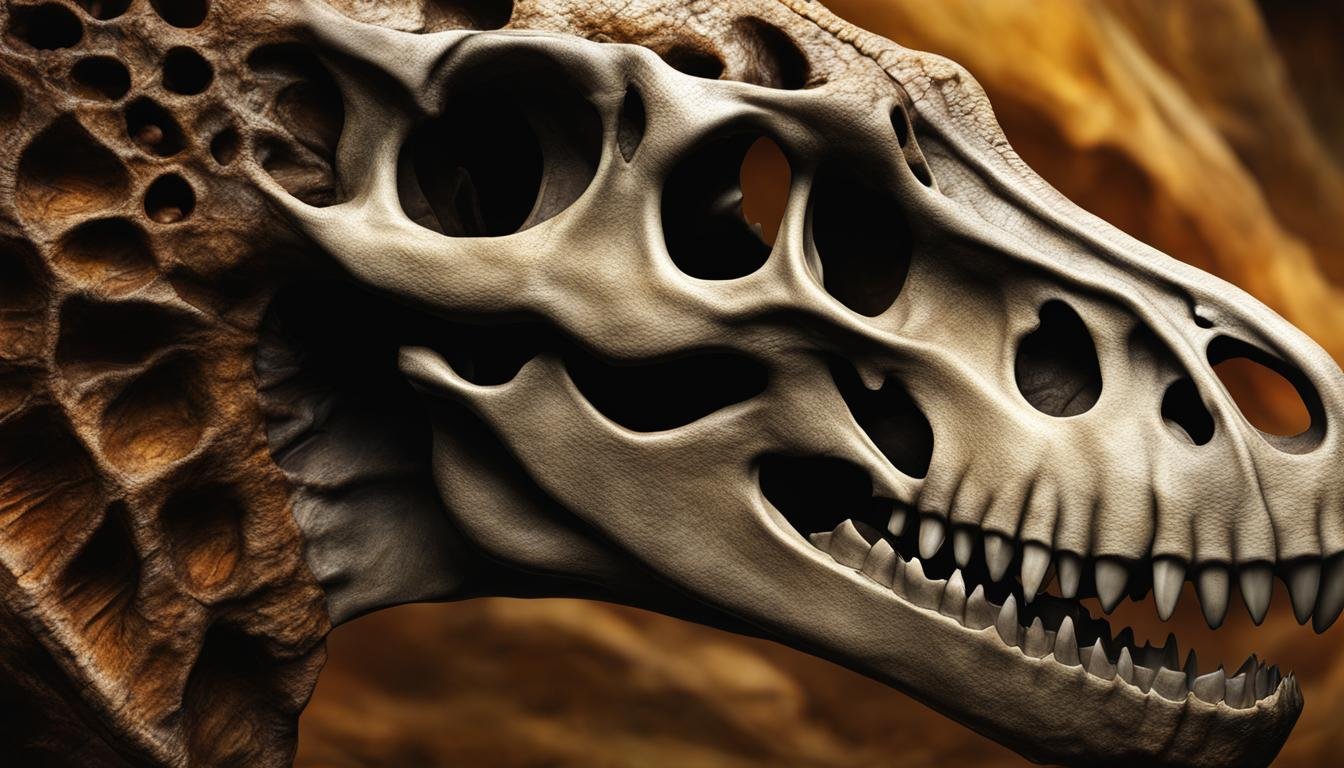Dinosaur Skeletal Structures provide valuable insights into the anatomy and behavior of these ancient creatures. The study of fossilized bones allows scientists to uncover the secrets of dinosaurs and their prehistoric world. Let’s explore the key elements of dinosaur skeletal structures, including vertebrae, skulls, tails, ribcages, and pelvises, and understand how they contribute to our understanding of these fascinating creatures.
Types and Features of Dinosaur Skeletons
Dinosaurs had diverse skeletal structures that varied based on their classification. Two main types of dinosaur skeletons are the Saurischian skeleton and the Ornithischian skeleton. The Saurischian skeleton is characterized by a lizard-like hip structure, while the Ornithischian skeleton has a bird-like hip structure.
One of the key factors that differentiate dinosaur skeletons is bone density. Some dinosaurs had dense bones, while others had hollow bones with marrow cavities. Dense bones provided strength and support, while hollow bones reduced the overall weight of the dinosaur, making it easier for them to move.
The study of dinosaur bones, known as osteology, plays a crucial role in understanding the structure and function of different skeletal elements. Osteologists examine dinosaur bones to determine how they were formed, identify different bone types, and study the growth patterns of dinosaurs.
| Dinosaur Type | Hip Structure | Bone Density | Marrow Cavities |
|---|---|---|---|
| Saurischian | Lizard-like | Dense | No |
| Ornithischian | Bird-like | Hollow | Yes |
Key Skeletal Features of Dinosaurs
Dinosaurs possess unique and fascinating skeletal features that contribute to their diverse and remarkable appearances. These features include specialized joints, growth rings in their bones, crests and horns, armored plates, and distinctive bipedal or quadrupedal skeletons.
Joints
Dinosaur skeletons exhibit specialized joints that allow for a remarkable range of movement and flexibility. These joints enabled dinosaurs to perform various actions such as running, leaping, and even grasping objects with their hands.
Bone Growth Rings
Similar to the growth rings found in trees, certain dinosaur bones contain growth rings that provide valuable insight into their age and growth rate. By analyzing these rings, scientists can estimate the age of a dinosaur and gain information about its growth patterns.
Crests and Horns
Many dinosaurs possessed elaborate crests and horns on their skulls, which served various purposes. These structures may have been used for display during courtship rituals or as defensive weapons against predators and rivals.
Armored Plates
Some dinosaur species, such as the Ankylosaurus, had bony armor plates along their bodies. These plates provided protection from predators and possibly influenced thermoregulation, helping to regulate the dinosaur’s body temperature.
Bipedal and Quadrupedal Skeletons
Dinosaur skeletons can be classified into two main types: bipedal and quadrupedal. Bipedal dinosaurs, like the Tyrannosaurus rex, had a two-legged skeletal structure and were adapted for swift movement and hunting. Quadrupedal dinosaurs, such as the Triceratops, had a four-legged skeletal structure and were more suited for stability and browsing on vegetation.
| Dinosaur Type | Examples | Features |
|---|---|---|
| Bipedal | Tyrannosaurus rex, Velociraptor | Two-legged structure, long tail for balance, sharp claws |
| Quadrupedal | Triceratops, Stegosaurus | Four-legged structure, herbivorous diet, horns or plates for defense |
Skeletons and Posture of Dinosaurs
Dinosaur skeletons provide valuable insights into their posture and overall body structure. By studying their skeletal remains, scientists can gain a better understanding of how dinosaurs moved and interacted with their environment. Let’s explore some key aspects of dinosaur skeletons and how they relate to posture and morphology.
Dinosaur Skull Morphology
The morphology of a dinosaur’s skull can provide important clues about its feeding habits and diet. For example, the shape and size of the jaw and teeth can indicate whether a dinosaur was herbivorous, carnivorous, or omnivorous. Some dinosaurs, like the T. rex, had large, powerful jaws with sharp teeth designed for hunting and tearing flesh. On the other hand, herbivorous dinosaurs, such as the Triceratops, had broad, beak-like mouths and flat teeth for grinding plant material.
“The morphology of a dinosaur’s skull can provide important clues about its feeding habits and diet.”
Joint Flexibility and Skeletal Adaptations
The flexibility of dinosaur joints played a role in their overall posture and movement. The structure of their joints allowed for a wide range of motion, enabling different types of locomotion. Some dinosaurs, like the Velociraptor, had highly flexible and agile limbs, which supported their ability to run and pounce on prey. In contrast, the heavy and massive limbs of sauropods, like the Brachiosaurus, were adapted for supporting their immense body weight.
Bone Fragility and Pathological Bones
While dinosaur bones were strong and durable, they were not invincible. Some dinosaur skeletons show signs of bone fragility or disease, providing evidence of pathological conditions. Pathological bones can give scientists insights into the health and well-being of dinosaurs, as well as any physical limitations they may have experienced during their lives.
In summary, the study of dinosaur skeletons reveals fascinating details about their posture and skeletal adaptations. From skull morphology to joint flexibility, scientists can piece together a picture of how dinosaurs moved and interacted with their environment. By analyzing bone fragility and pathological conditions, researchers gain a deeper understanding of the challenges dinosaurs faced during their prehistoric existence.
Importance of Dinosaur Skeletons
The study of dinosaur skeletons and fossils plays a crucial role in advancing our scientific understanding of these ancient creatures. Dinosaur fossils, including fossilized bones and imprints, provide valuable evidence of the existence of these magnificent creatures that roamed the Earth millions of years ago.
The analysis of dinosaur fossils has led to significant scientific discoveries, shedding light on their anatomy, behavior, and evolutionary history. By examining the structure and features of dinosaur skeletons, paleontologists can infer details about their physical characteristics, such as their size, shape, and locomotion. This information helps reconstruct their lifestyle and ecosystem, offering insights into the ancient world.
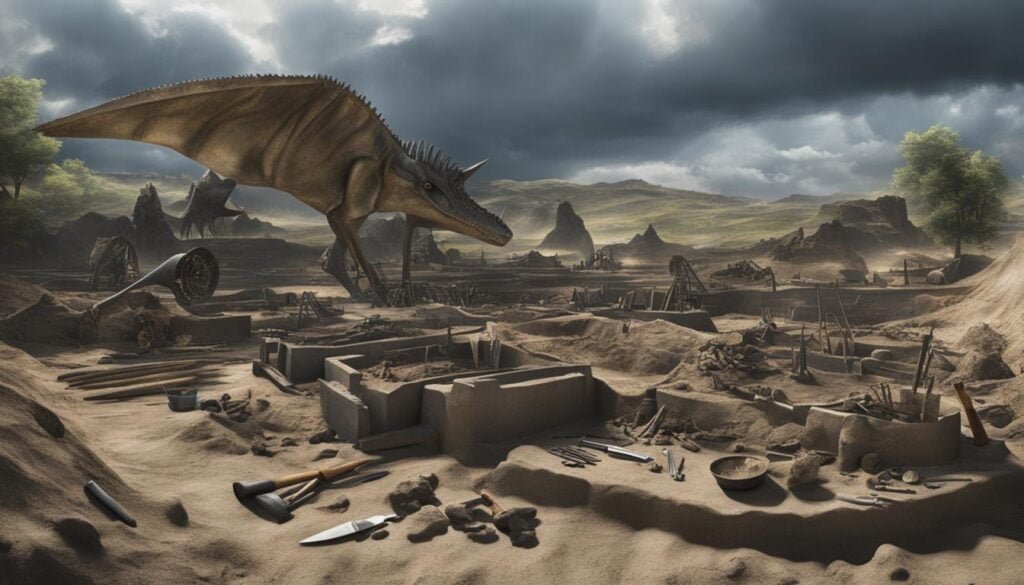
Furthermore, the study of dinosaur skeletons contributes to our understanding of evolution. By comparing the skeletal structures of different dinosaur species, researchers can identify patterns and relationships, enabling them to reconstruct the evolutionary tree and map the diversification of these creatures over time.
Scientific Discoveries
Scientific discoveries resulting from the examination of dinosaur skeletons have expanded our knowledge of prehistoric life. Through detailed analysis and interpretation of these fossils, paleontologists have uncovered new information about the behaviors and adaptations of dinosaurs. For example, by studying the structure of dinosaur skulls, scientists have gained insights into their feeding habits and diet, whether they were herbivores, carnivores, or omnivores.
“The analysis of dinosaur skeletons and fossils has revolutionized our understanding of prehistoric life.” – Dr. Sarah Thompson, Paleontologist
Paleontological research also provides evolutionary insights into how dinosaurs evolved and diversified. By studying the changes in skeletal structures among different dinosaur species, scientists can track the development of new adaptations over time, leading to the emergence of new lineages and the extinction of others.
| Dinosaur Fossils | Scientific Discoveries |
|---|---|
| Ankylosaurus | Revealed the existence of armored dinosaurs and their unique defense mechanisms |
| Deinonychus | Provided evidence of the presence of feathers in certain dinosaur species |
| Tyrannosaurus rex | Unveiled the iconic appearance and predatory nature of this fearsome dinosaur |
Discovery and Study of Dinosaur Skeletons
The study of dinosaur skeletons involves a combination of paleontological excavations, fieldwork, fossil preparation, museum collections, and advanced imaging techniques. Paleontologists embark on expeditions to excavate dinosaur fossils from various sites around the world. These excavations require meticulous work to carefully remove the surrounding sediment and reveal the preserved bones. Fossil preparation techniques are then used to clean and stabilize the fossils for further study.
Once the dinosaur skeletons are prepared, they are either stored in museum collections for preservation or put on display for public education and research purposes. Museums play a vital role in the study of dinosaur skeletons, as they provide a central location where scientists can access and study these valuable specimens. Museum collections allow for comparative analysis between different dinosaur species and provide a wealth of data for paleontological research.
Advanced imaging techniques, such as X-ray imaging, are also utilized to study the internal structures of dinosaur bones. This non-invasive method allows scientists to examine the intricate details of the skeletal elements without causing damage to the fossils. X-ray imaging helps reveal the internal morphology and any anomalies or pathologies present in the bones, providing further insights into the lives of these ancient creatures.
| Paleontological Excavations | Fieldwork | Fossil Preparation | Museum Collections | X-ray Imaging |
|---|---|---|---|---|
| Excavation of dinosaur fossils from various sites around the world | Field expeditions to uncover and document dinosaur fossils | Cleaning, stabilizing, and preparing fossils for study | Storage and preservation of dinosaur skeletons in museum collections | Non-invasive imaging technique to examine internal bone structures |
| Unearthing valuable specimens for scientific research | Mapping and documenting fossil locations and geological context | Removing surrounding sediment to reveal preserved bones | Allowing scientists access to study and compare different species | Revealing internal morphology, anomalies, and pathologies |
Diversity of Dinosaur Skeletons
Dinosaurs were a diverse group of prehistoric creatures with unique skeletal structures. The differences in their skeletons allowed them to adapt to various environments and lifestyles. Let’s explore the diversity of dinosaur skeletons, focusing on the structures of theropods and sauropods, as well as their limb bones, claws, and teeth.
Theropod Structure
Theropods were a group of bipedal dinosaurs known for their carnivorous feeding habits. Their skeletal structure was adapted for agility and efficient hunting. These dinosaurs had lightweight skulls with sharp, serrated teeth for tearing flesh. They also had powerful limb bones, allowing for fast and agile movements. Claws on their hands and feet provided a strong grip, aiding in capturing prey.
Sauropod Structure
Sauropods, on the other hand, were massive dinosaurs with long necks and tails. Their skeletal structure was adapted to support their enormous size and weight. They had elongated neck bones and sturdy limb bones, providing stability and balance. The teeth of sauropods were mainly designed for herbivorous feeding, allowing them to graze on vegetation.
| Dinosaur Group | Limb Bones | Claws | Teeth |
|---|---|---|---|
| Theropods | Lightweight and agile | Sharp and curved for capturing prey | Serrated for tearing flesh |
| Sauropods | Sturdy and supportive | Relatively small and blunt | Designed for herbivorous feeding |
The diversity in the skeletal structures of dinosaurs allowed them to occupy different ecological niches and thrive in various habitats. While theropods had adaptations for hunting and predation, sauropods had adaptations for herbivorous feeding and supporting their massive bodies. By studying these skeletal structures, scientists can gain insights into the behaviors and lifestyles of these fascinating creatures that once roamed the Earth.
Skeletons and Behavior of Dinosaurs
The study of dinosaur skeletons provides valuable insights into their behavior. By analyzing the skeletal remains of these ancient creatures, scientists can make observations and draw conclusions about how dinosaurs lived and interacted with their environment.
Herd Behavior
One fascinating area of study is herd behavior among dinosaurs. Fossil evidence suggests that some dinosaur species lived and moved in groups. For example, the discovery of a large number of fossilized dinosaur footprints in the same location indicates that these dinosaurs traveled together in herds. The presence of multiple individuals of different ages and sizes further supports the idea of group behavior. By examining dinosaur skeletons within these herds, scientists can gain insights into social structures, migratory patterns, and defensive strategies.
Nesting Behavior
Dinosaur nests and eggs provide another window into their behavior. Paleontologists have discovered fossilized nests that contain clusters of eggs, indicating that dinosaurs engaged in nesting behavior similar to modern birds. The size and arrangement of the eggs can indicate the species responsible for the nest and provide clues about incubation and parental care. By studying these nesting sites and examining the remains of embryos found within the eggs, scientists can learn more about dinosaur reproductive habits and how they cared for their young.
Locomotion and Defense Mechanisms
The skeletal structure of dinosaurs also offers insights into their locomotion and defense mechanisms. By examining the size and shape of limb bones, scientists can determine whether a dinosaur was capable of bipedal (walking on two legs) or quadrupedal (walking on four legs) locomotion. This information helps reconstruct how dinosaurs moved and navigated their environments.
Additionally, certain dinosaur skeletons reveal adaptations for defense. Some dinosaurs had bony plates, spikes, or armor that provided protection against predators. By studying these structures and their placement on the skeleton, scientists can infer the defensive capabilities and strategies of different dinosaur species.
| Behavior | Observations |
|---|---|
| Herd Behavior | Fossilized footprints and groupings of skeletons indicate group travel and social structures. |
| Nesting Behavior | Discovery of fossilized nests and eggs provide insights into dinosaur reproductive habits and parental care. |
| Locomotion | Examination of limb bones allows scientists to determine if dinosaurs walked on two or four legs. |
| Defense Mechanisms | Structures such as bony plates and spikes suggest adaptions for defense against predators. |
Dinosaur Skeletons and Extinct Species
The study of dinosaur skeletons provides invaluable information about extinct species and their relationships to modern organisms. By examining the fossil record, which comprises dinosaur skeletons and other fossils, scientists can gather evidence of past extinction events and the subsequent evolution of new species. Comparative anatomy plays a crucial role in connecting ancient dinosaurs to their modern counterparts, shedding light on the evolutionary history of life on Earth.
The fossil record serves as a window into the past, offering a unique glimpse into the diversity and complexity of ancient ecosystems. By studying the fossils of different dinosaur species, paleontologists can piece together the puzzle of extinction events and understand how various factors, such as changes in climate or competition for resources, contributed to the disappearance of certain species.
| Dinosaur Species | Extinction Event | Comparative Anatomy |
|---|---|---|
| Tyrannosaurus rex | K-T extinction event | Similarities in skeletal structure to modern birds |
| Triceratops | Mesozoic extinction event | Distinctive frill and horns |
| Stegosaurus | End-Triassic extinction event | Unique arrangement of plates along the back |
The table above showcases some dinosaur species, the corresponding extinction events, and notable features of their comparative anatomy. By analyzing the similarities and differences between ancient and modern skeletal structures, scientists gain valuable insights into the evolutionary relationships and adaptations of these extinct species.
In conclusion, the study of dinosaur skeletons, combined with the fossil record and comparative anatomy, enables scientists to explore the fascinating world of extinct species. By unraveling the mysteries of the past, researchers continue to expand our understanding of the natural history of our planet and the diverse life forms that have inhabited it.
Reconstructing Dinosaur Skeletons
Paleontologists play a crucial role in reconstructing dinosaur skeletons, allowing us to visualize these awe-inspiring creatures as they appeared in life. Through the careful process of articulation and reassembling bones, scientists bring these ancient giants back to life, providing us with a glimpse into the past.
The first step in reconstructing dinosaur skeletons is the creation of skeletal mounts. These mounts involve articulating the fossilized bones in their approximate positions, based on anatomical knowledge and comparative data. This meticulous process requires a deep understanding of bone shape, size, and orientation, as well as the unique anatomy of each dinosaur species.
“Reconstructing dinosaur skeletons is like solving a complex puzzle,” says Dr. Jane Parker, a renowned paleontologist. “We carefully analyze each bone and its relationship to the others, ensuring that the final mount accurately represents the dinosaur’s anatomy.”
Reassembling dinosaur bones can be a challenging task, as fossilized bones are often fragmented or damaged over millions of years. Paleontologists must carefully analyze each bone and consider its position within the overall skeleton. They may use techniques such as 3D scanning and digital modeling to aid in the reconstruction process, ensuring that the final mount is as accurate as possible.
| Dinosaur Species | Articulation Process |
|---|---|
| Tyrannosaurus rex | Based on comparative data and knowledge of related theropod dinosaurs |
| Triceratops | Analysis of skull and limb bone structure to determine proper articulation |
| Stegosaurus | Consideration of unique plate arrangement and tail posture |
The reconstructed skeletons that result from this meticulous process provide a visual representation of what dinosaurs would have looked like in life. They allow us to marvel at the immense size, strength, and beauty of these ancient creatures, transporting us back to a time when dinosaurs ruled the Earth.
Advancements in Dinosaur Skeletal Research
Recent advancements in technology have revolutionized the study of dinosaur skeletons. One such advancement is the use of 3D scanning techniques, which allow for detailed digital models of dinosaur bones. These scans provide scientists with a wealth of data that can be analyzed and compared in virtual space. With 3D scanning, researchers can examine the intricate details of dinosaur skeletons, such as the shape and structure of individual bones, the presence of fractures or pathologies, and even the fine texture of the surface.
This technology has proven particularly useful in cases where fragile or rare dinosaur fossils are too delicate to handle or study directly. By creating accurate digital replicas, scientists can explore the inner workings of dinosaur anatomy without risking damage to the original specimens. Additionally, this digital data can be shared and accessed by researchers all over the world, promoting collaboration and advancing our collective understanding of dinosaur skeletal structures.
“3D scanning techniques have opened up new avenues of research and exploration in the field of paleontology,” says Dr. Emma Johnson, a leading expert in dinosaur skeletal analysis. “The ability to create digital models of dinosaur bones has allowed us to study these ancient creatures in ways we never thought possible. We can now uncover hidden details, investigate biomechanics, and even simulate movements of dinosaurs with remarkable precision.”
Another significant advancement in dinosaur skeletal research is the use of digital modeling. By combining data from 3D scans with computer algorithms, researchers can reconstruct complete dinosaur skeletons in virtual space. These digital models can be manipulated and analyzed from any angle, allowing scientists to gain a deeper understanding of the structure and function of dinosaur bones. Digital modeling also enables scientists to simulate movements and behaviors, providing valuable insights into how dinosaurs may have moved and interacted with their environment.
The Benefits of Biomechanical Analysis
Biomechanical analysis is yet another tool that has transformed our understanding of dinosaur skeletal structures. By applying principles of physics and engineering to dinosaur skeletons, scientists can gain insights into how these ancient creatures moved and supported their massive bodies. This analysis involves studying the size, shape, and distribution of bones, as well as the angles and ranges of joint motions.
Through biomechanical analysis, researchers can determine the capabilities and limitations of different dinosaur species. For example, by studying the structure of a dinosaur’s leg bones, scientists can estimate its running speed and agility. Analysis of the neck and spinal structure can provide clues about how a dinosaur supported its long neck or how it used its tail for balance.
| Dinosaur Species | Estimated Running Speed (mph) | Biomechanical Adaptations |
|---|---|---|
| Tyrannosaurus rex | 20-25 | Powerful legs and tail for fast pursuit of prey |
| Triceratops | 5-10 | Thick, sturdy legs for slow, ponderous movement |
| Velociraptor | 25-30 | Lightweight body and long limbs for swift, agile hunting |
Biomechanical analysis has revealed fascinating insights into the abilities and adaptations of different dinosaur species, shedding light on their unique locomotion strategies and ecological roles.
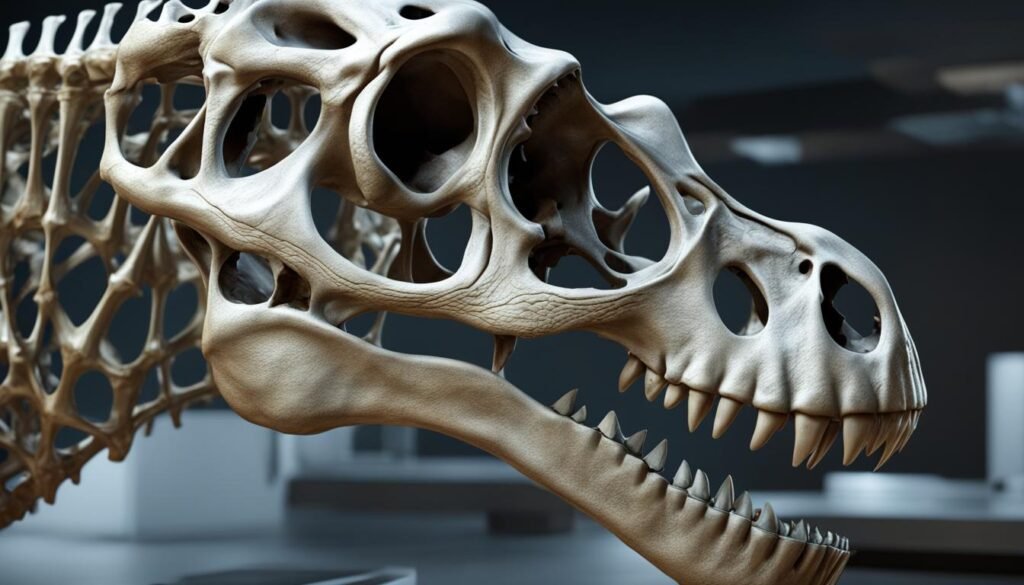
These advancements in 3D scanning, digital modeling, and biomechanical analysis have opened up new frontiers in the study of dinosaur skeletal structures. As technology continues to evolve, so too does our understanding of these ancient creatures. By harnessing the power of technology, scientists are able to unlock the secrets of the past and paint a more complete picture of the remarkable world of dinosaurs.
Conclusion
In conclusion, the study of dinosaur skeletal structures has provided us with invaluable knowledge about these ancient creatures. Through the examination of fossilized bones and the reconstruction of skeletons, scientists have made significant discoveries regarding the anatomy, behavior, and evolution of dinosaurs.
Dinosaur skeletal structures reveal unique features that distinguish them from other archosaurs. From their reduced digits on their hands to their open hip sockets, these skeletal elements help classify dinosaurs into different groups. The skulls of dinosaurs, with their diapsid structure and extra holes, provide insights into their biology and evolution.
Furthermore, the posture and skeletal adaptations of dinosaurs are closely linked. By analyzing the morphology of their skulls and the flexibility of their joints, scientists can infer their feeding habits, movement patterns, and defensive mechanisms. The diversity of dinosaur skeletons, with variations in limb bones, claws, and teeth, reflects their evolutionary adaptations to different environments.
In summary, dinosaur skeletons serve as windows into the past, allowing us to explore and appreciate the incredible diversity and majesty of these long-extinct giants. By studying dinosaur skeletal structures, we continue to uncover the secrets of their prehistoric world and gain a deeper understanding of the history and evolution of life on Earth.

